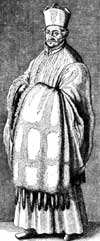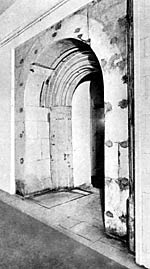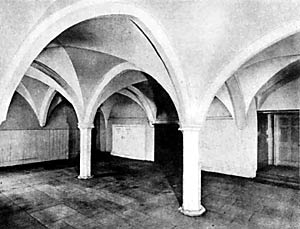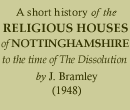< Previous | Contents | Next >
Welbeck Abbey
 |
| Premonstratensian Canon. |
Welbeck Abbey was situated in the heart of Sherwood Forest, in a more lonely spot than its neighbour Rufford Abbey as it was further from the main road.
This abbey for White Canons was founded about the end of Henry II's reign (1154-1189) by Thomas de Fleming, a descendant of Joceus de Fleming of Cuckney, who came over with the Conqueror. Thomas endowed the abbey and others followed his example, and it eventually owned land in three counties.
The Premonstratensian or White Canons were established by St. Norbert, a German who was born in 1080, and their first house was founded at Premontre, near Laon in France, and they followed the Rule of St. Augustine. The Premonstratensian canons wore a long white cassock with a rochet above it, and were usually referred to as the White Canons. All their houses in this country were subject to Premontre until 1512, in which year they were placed under the Abbot of Welbeck. For some thirty years before that date they had been under the supervision of Bishop Redman while Abbot of Shap.
 |
| Doorway in east wall of west cloister range, Welbeck Abbey. |
Welbeck was visited no fewer than eleven times between 1462 and 1500 by Redman, Commissary General of the Order. Among other faults he complained about the sporting proclivities of the canons, about the poor quality of the ale and bread, but he authorised the prior to wear woollen underclothing on account of his age. When Redman visited in 1482 he found that they had put the abbey jewels and plate in pawn, neglected the fabric and were generally lax, so he deposed the abbot and ordered him to do penance elsewhere. When this indefatigable Visitor died while Bishop of Ely, one of the Welbeck canons succeeded him as Commissary General of the Order. Between 1475 and 1500 the average number of canons at Welbeck was about twenty-two. Welbeck became the mother house of seven daughter houses.
When Legh and Layton visited in 1536 they found the annual income to be £280 and the debts to be £40. They also alleged that four canons were guilty of moral offences—not a heavy calendar for these two inquisitors. The abbey was surrendered in 1538 by Abbot Richard Bentley, and he was awarded a pension of £50, i.e. about £2,500 a year, while seventeen canons received pensions which varied from £40 to £4 per annum, including three of the four canons against whom grave allegations had been made. There were about twenty canons and an abbot when the abbey surrended.
 |
| West cloister range; interior of ground floor, Welbeck Abbey. |
In 1538-1539 Richard Whalley of Shelford leased the abbey site on terms not known, but in 1600 the reversion was purchased for the Earl of Shrewsbury for £555 6s. 8d. Part of the west range of cloisters forms part of the basement of the present abbey, and more survived till about 1750.
